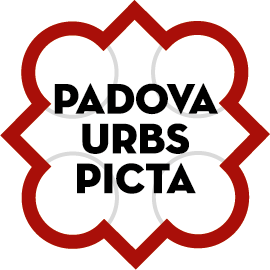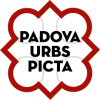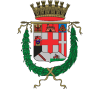Our guides in exploring a culture which reconciled deep Christian faith with a profound interest in astrology are the stars and comets depicted in so many of the frescoes that adorn the buildings to be visited. The starting-point for the entire visit is the Scrovegni Chapel, where – at the behest of the banker Enrico degli Scrovegni – Giotto painted a series of frescoes that were his masterpiece and are now recognised as a turning-point that marked the beginning of modern painting.
The first star we see here is the comet that appears in the scene of The Nativity. This is the very first example of the now familiar image of a star above a humble stable with the new-born Infant Jesus. It is also a very realistic depiction of this astronomical phenomenon, with a ball of fire and a long trail of light: we know, in fact, that Halley’s Comet was visible in the skies in the year 1300, when Giotto was painting these frescoes, and he here depicts it with scientific exactitude. His interest in such celestial phenomena may in part have been due to his links with scholars at the University of Padua, and with one figure in particular: Pietro d’Abano, who created within the university the bases for the scientific culture that would, centuries later, enable Galileo Galilee to describe the institution as a ‘fertile mother’ of the sciences. The realism in the depiction of the star in the Nativity scene is in clear contrast with the depictions of stars elsewhere in the Chapel, particularly with the red and blue stars that are painted in the crypt: the symbolic form and colours of these stellar bodies suggest that they are those associated with the Order of the Knights Templar, who may once have held meetings in the Scrovegni Chapel. One can, in fact, recognise the image as that of the Morning Star, which had get symbolic significance for the Templars.
Just a couple of steps from the Chapel itself is the large and imposing church of the Augustinian order of the Friars Eremitani. The interior has a spectacular keel-vault roof, and the apse of the church contains work by the first great Paduan artist to follow in Giotto’s footsteps: Guariento. Here again there is an example of a fusion between astrology and Christianity. Beneath the large fresco of Paradise (which was destroyed during a bombing raid in WWII) and still extant frescoes depicting scenes from the lives of Saints Philip, Augustine and James, Guariento added a lower band of images with allegories of the Planets and the various Ages of Man. The iconography follows the ideas of the ancient Romans, who believed there was a close link between the seven planets, the seven Ages of Man and the seven days of the week.
In the Middle Ages, too, there was a strong belief that the cosmos as such was a living entity, through which flowed energies that exerted continual influence on the life of sublunary creatures. This notion of a harmonic relationship between the micro- and macrocosm was an established idea in the Padua of the day, and one finds a very forceful presentation of it in the enormous Palazzo della Ragione, which once housed the city’s law courts.
From the church of the Eremitani, it is a short walk to the city’s central piazzas, with their colourful open markets. Separating two of these three squares is a large structure that the Paduans refer to solely as Il Salone: the Palazzo della Ragione, which is considered to be the most famous public hall of medieval Europe. Covered by a breath-taking keel-vault roof, that hall is decorated with the largest astrological fresco in the world, the iconography for which was drawn from Ptolemy’s Astronomy and Pietro d’Abano’s Astrolabium Planum.
The whole work is a fascinating and complex composition, a number of the images in which have hidden meanings. With an inverted keel above and depictions of the constellations all around, the interior of this magnificent hall in some way creates the impression of a wonderful space vessel carrying one through the universe. In many ways, the Palazzo della Ragione can be said to mark the highest point in the city’s history, when its civil institutions and its mercantile power were in perfect harmony, and intellectual ideas were modelling an environment that would be ideal for the emergence of modern science.
Just slightly beyond the Palazzo della Ragione stands the Palazzo del Bò, the university building where Galileo Galilee would teach for 18 years. Benefitting from the intellectual freedom that existed in the Padua of the day, Galileo would be able to pursue the scientific research that made such a contribution to acceptance of the heliocentric model of the solar system. He was preceded at the university by other professors of great renown.
These included the Dondi brothers, who would become known as the Dondi d’Orologio because they created the extraordinary mechanical clock (orologio) that one can now see in Piazza dei Signori.
Physicians and astrologers, the two brothers would also create the famous Astrarium in Palazzo del Bo; its cubic form contains a complex mechanicism that made it possible to determine the position of the planets at any specific time of day, and thus the machine was used in casting horoscopes. The Dondi were also court astrologers to the Carraresi, who in 1399 would establish a permanent Chair of Astrology in the Faculty of Arts and Medicine.
It is easy to imagine the prince and his astrologer on the small extant terrace of what remains of the Carraresi Palace, looking up at the stars and trying to decide upon the correct moment to undertake specific actions which would determine whether the city was at war or at peace. Perhaps after make those decisions, the prince then retired to pray for further guidance in the small palace chapel, another part of that royal complex that has surveyed; it is now part of the premises of the Accademia di Scienze, Lettere ed Arti.
Within that chapel space itself there are extant frescoes by Guariento depicting scenes from the Old Testament. However, visitors will no longer find here the ranks of angels that once adorned the ceiling of the chapel. Inspired by the philosophical/theological culture of the time, these figures have been moved to the City Museum at the Eremitani. Yet though now to be seen within a museum setting, they can still create the effect of a fantastical heavenly hierarchy.
Close by the Accademia is the Cathedral Baptistery, which houses works that another Giotto-inspired artist – Giusto de’ Menabuoi – painted for the Carraresi court, creating a sort of Summa Teologica that combines scenes from the Old and New Testaments. The cube-shaped building is topped by a central cupola whose fresco depicts Paradise; at the centre of this heavenly space, Guariento shows Deus Pantocrator, the creating god who embodies the Thomist notion of the One that generates the Many. Around this deity are hierarchies of angels and saints, their haloes glowing in the dark interior. The whole composition forms a veritable universe, with the sun at the centre and innumerable ranks of satellites moving in fixed orbits around it.
From Piazza del Duomo one can walk to the structure that in the eighteenth-century became the city’s astronomical observatory: the Specola, housed in one of the towers of the old city walls. After visiting this fascinating structure, one moves on to the nearby Oratory of San Michele. Here we find another comet; this time its presence is linked with the history of the Carraresi family, who had a profound belief in the significance of astrological signs. The frescoes in this oratory are by another Giotto-influenced artist, Stefano da Verona. The images depict various members of the Carraresi dynasty, with the princely rulers shown as the Magi – for not only were they too kings, but they had also been ‘guided’ by a star. In fact, the comet shown embroidered on the robe of Francesco I Carraresi serves as a heraldic device that symbolises the ‘rebirth’ of this family’s power after Padua had thrown off the rule of the Scaligeri of Verona, who were the traditional enemies of the Carraresi. Contemporary chronicles relate that in 1337 a comet with a long tail appeared in the sky above Verona, like a sword whose long sharp blade pointed down to the city. This would prove to be an unhappy omen for the forces of Verona but a lucky one for the Carraresi, who soon after would see their court and power return to their previous splendour.
Elsewhere in Padua one can find other depictions of the various Carraresi rulers of the city: in the Chapel of the Black Madonna and the Chapel of San Felice (both within the Basilica of St. Anthony) and in the Oratory of St. George. Following a route that will take one to see these frescoes, one first comes to the magnificent Prato della Valle, the second-largest urban square in Europe.
This is just a short distance from the Basilica of St. Anthony, a place of pilgrimage that every day attracts hundreds of the faithful from all over the world. As well as being a very important centre of religious worship, the Basilica is also very rich in artistic treasures. Alongside the magnificent high altar sculpted by Donatello are a range of frescoes (in the above-mentioned chapels) by Altichiero, Avanzo and Giusto de’ Menabuoi. Here one sees the art of Giotto developing into the more courtly International Gothic style, which one might take as the culmination of the various reinterpretations of that artist’s work.
All in all, it is the full range of these developments upon Giotto’s achievements in the Scrovegni Chapel that make Padua home to one of the world’s richest collections of fourteenth-century fresco work.












